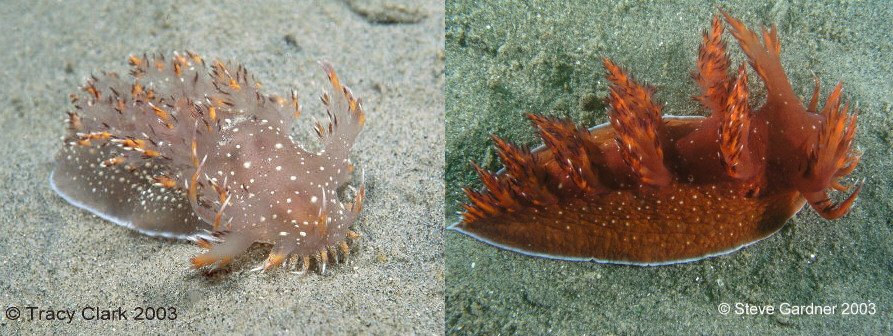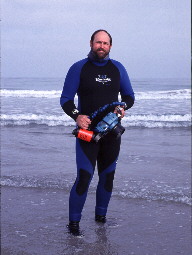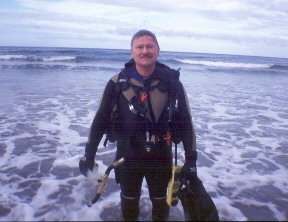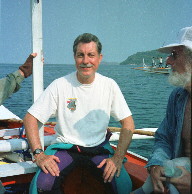 |
Dendronotus iris
Photos couresty of Tracy Clark and Steve GardnerLa Jolla Shores, San Diego, Calif. August 2003
Dendronotus iris Cooper, 1863
Well this week has been an exciting one for divers in the San Diego, California area. Seems a favorite dive spot referred as the La Jolla Shores became the site of a huge gathering and love in for one of the larger species of Branchs from this coast, Dendronotus iris .
As the name implies this Dendronotid is red in color, but varies greatly from the original "color-nym." Light specimens fading to white fading to white are common. One feature all the color variations share is the white line along the edge of the foot. Some pure red examples can also be seen with this line.
Why so many animals were gathered at the same time is unknown. I even question whether this species favorite prey, the burrowing anemone Pachycerianthus fimbriatus , is abundant enough here to provides a days meals for such a huge population explosion. As you can see in this photo the anemones are pretty darn small. Veteran Shores divers Steve Gardner and Tracy Clark report that in about 50 feet deep, on the sandy bottom of the Shores, population densities were up to at least 1 specimen per square meter. That's a lot of this species. What started with isolated areas of instense activity a couple of weeks ago has spread to a general "population bloom" from the Marine Room restaurant to the Life Guard Tower at La Jolla Shores, San Diego, Calif.
Population explosions such as what is currently being seen at La Jolla Shores are being reported more frequently. The species that seems to occur in masses most often is Onchidoris bilamellata , a barnacle feeding dorid nudibranch. As seen in photos on the Forum, literally thousands of individuals have been documented covering the bottom, even right here in California, leaving a path of destroyed barnacles and a pasture of white egg coils behind them. Such population explosions are usually short lived, the animals dying off quickly due to lack of food.
D. iris forage across sandy bottoms in search of tube anemones. When one is located the species arches back and attacks the oral disc of the anemone, much like the arched body of a striking King cobra. This usually results in the nudibranch being pulled into and down the tube of the burrowing anemone as it retracts, hoping to find safety. The nudibranchs always hold on and finish off their meal .
The photos included here clearly show the broad foot characteristic of sand bottom foraging opisthobranchs like Cerberilla and the while line along the edge of the foot. We also see the mating of light and dark individuals and the huge stringball-like egg masses laid after copulation. Sometimes D. iris seems to get carried away in this activity as evidenced by this photo .
D. iris is also one of the more accomplished opisthobranch swimmers. When disturbed or dislodged from the substrate individuals arch their bodies back and forth, pulling them selves into the water column. A video clip from Stan House... includes some free-swimming Dendronotus iris near the end. It's the top clip -- 1.2 MB in WMV format posted on the Divebums Website courtesy of Administrator John Moore and Stan House. This behavior may have several benefits, including being able to cover large areas in search of anemone food. The specimens here in San Diego are ranging from 25 to 75 mm in length. Kerry Werry's web site reports that specimens in British Columbia can reach 12 inches in D. iris put up on the Slug Site as the result of the Webmaster traveling to British Columbia to see the "gonzilla" version of this unique branch.
We'll have to stay in touch with the San Diego group to learn what becomes of this nudibranch explosion.
Danville, Calif
Sept. . 2003
Tracy Clark at La Jolla Shores

Tracy's pictures was taken with a Nikon N90, Subal housing, two YS-90 strobes. You will find Tracy at La Jolla Shores almost every weekend.
Send Tracy mail at tdclark@adnc.com |
Steve Gardner at La Jolla Shores

I asked Steve to give slug site readers an insight to his experience with his new Olympus 5050Z digital camera. The following is his reply: "... I have a Olympus 5050Z camera housed in a Ikelite Digital housing. Two Ikelite DS50 strobes were included with the TTL package. This system uses slave sensors to fire the strobes. There is no direct connection through the housing to the strobes. I shot the Dendronotus iris photos in the Super Macro mode in Manual with the all time Auto Focus on. An F Stop setting of 8 (the highest setting available) at 100th of a second was used in conjunction with an ISO setting of 100. The Super Macro is really great and allows me to nearly touch the subject and still get the photo. If I were not using my two external strobes, I would not get an image as the onboard strobe gets blocked by the lens. Digital Photography is definitely challenging. I have had trouble getting the lighting right but I am improving. Having instant images displayed really helps in making changes to the lighting and composition ..."
Send Steve mail at stevebumblebee@san.rr.com |
Steve was kind enough to take the Webmaster on a guided tour of his "backyard" this Sunday morning, Aug. 31st.. The area characterized by the high abundance of Dentronodus just acquired a name this morning thanks to another veteran shores diver, Kerry Mahoney. How does "Dentronodus Flats" sound??? The "Great Dentronotus Bloom of 2003 at La Jolla Shores" seems to be on the wane now. Don't despair however, the Dentronotus Bloom is currently being replaced by a " Hermissenda crassicornis Bloom." They were everywhere this morning!! With all this activity one still heres a familar refrain, .."why dive the shores, there's nothing but a lot of sand out there..."
Taxonomic information courtesy of:

David W. Behrens
Author:
Pacific Coast Nudibranchs
Send Dave mail at dave@seachallengers.com
|
